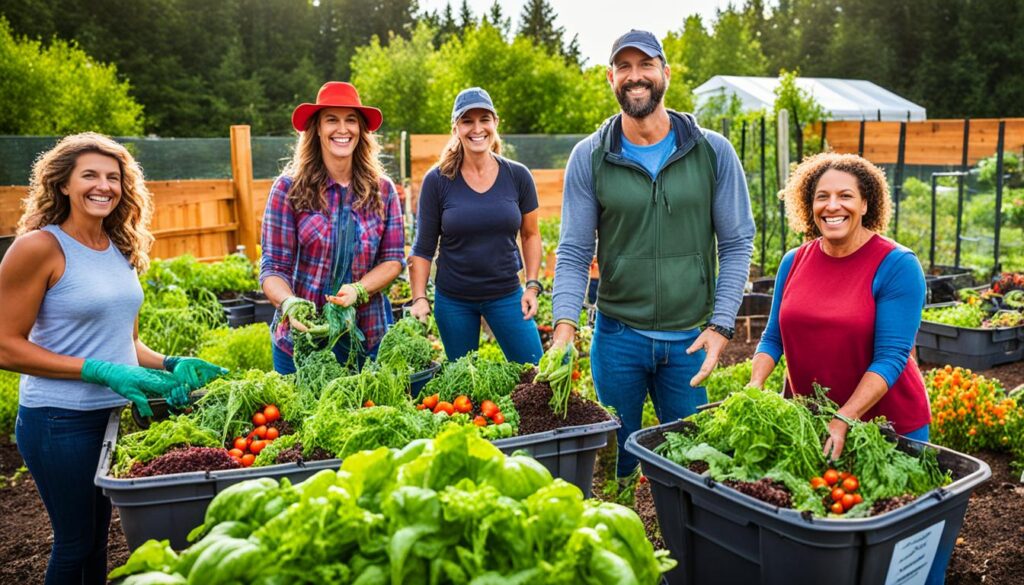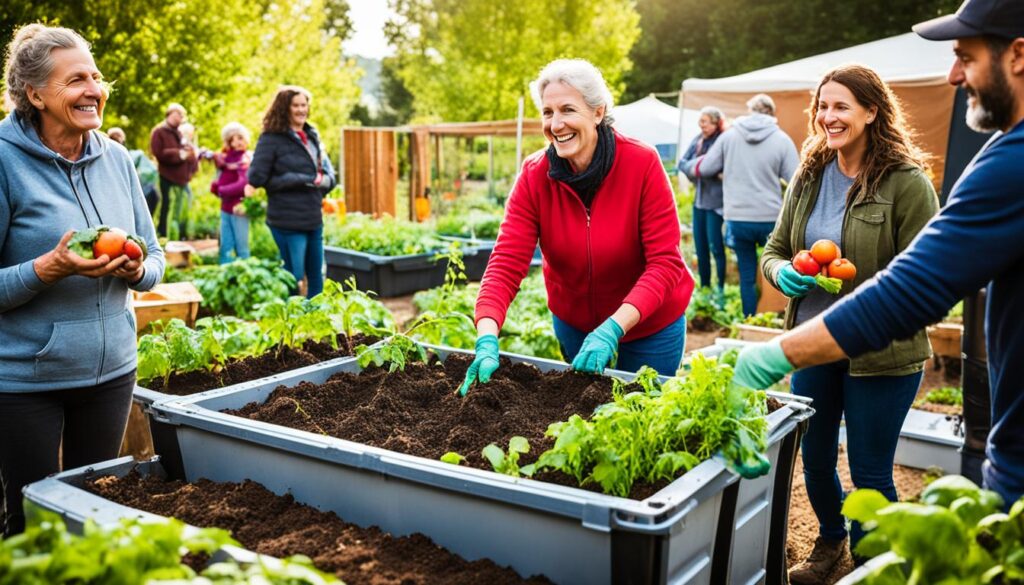Sustainable Harvesting Practices: Enjoy Your Garden’s Bounty
Have you ever had too much fresh produce from your garden and didn’t know what to do with it? Sustainable harvesting practices can help you enjoy your garden’s harvest while helping the environment and your community. We’ll look into sustainable harvesting, its benefits, and how to do it right.
Key Takeaways
- Discover the importance of sustainable harvesting practices for your garden
- Learn how to plan and time your harvest for maximum efficiency
- Explore eco-friendly preservation methods to enjoy your garden’s bounty year-round
- Discover how to share your surplus produce with your community
- Gain insights on how to incorporate sustainable practices into your garden planning for the next season
Are you ready to unlock the full potential of your garden and contribute to a more sustainable future? Let’s dive in and explore the art of sustainable harvesting practices together.
The Importance of Sustainable Harvesting
Adopting sustainable gardening is crucial for your garden’s health and the planet’s. Using organic methods and skipping synthetic fertilizers and pesticides helps. This approach boosts soil quality, cuts down on greenhouse gases, and lessens harmful runoff. It’s good for the earth and encourages eating more fruits and vegetables.
It also means using fewer single-use plastics, helping us move towards a sustainable future.
Benefits of Sustainable Harvesting
Sustainable gardening and harvesting bring many benefits, such as:
- Better soil health and fertility with organic additives
- Less pollution and greenhouse gases by avoiding synthetic chemicals
- Healthier eating for families with more fresh, homegrown produce
- Less need for single-use plastics, supporting eco-friendly food storage and preserving garden produce
By choosing these sustainable ways, you get to enjoy your garden’s bounty and help make a greener, healthier future for everyone.
“Sustainable gardening is not just a hobby; it’s a way of life that benefits both our personal health and the health of the environment.”
Planning Your Harvest
Successful garden planning is crucial for a great sustainable gardening harvest. Think about when different crops ripen, the best ways to pick them, and how to preserve and store your crop storage. Using clean tools and containers helps keep your harvest fresh longer.
Try succession planting to have a steady harvest instead of too much at once. This way, you can enjoy your garden’s produce all season, not just in one big batch.
- Plan for the ripening times of different crops
- Determine the best harvesting techniques for each type of produce
- Consider how you will preserve and store your garden’s yield
- Utilize succession planting for a steady, manageable harvest
“Careful planning is the foundation of a successful, sustainable harvest.”
By planning your garden planning and sustainable gardening well, you can make the most of your garden’s produce. You’ll waste less and enjoy more. The planning you do now will reward you with delicious harvests later.
Harvesting Techniques
Timing is Key
Timing is crucial when it comes to harvesting tips. Each crop has its own signs of readiness, like color, size, and texture. Knowing when to pick your crops is key to getting the best taste and quality.
It’s also vital to handle your harvested crops carefully. Clean tools and containers help keep them fresh and nutritious. Also, think about the storage conditions like temperature and humidity to keep your crops in top shape.
Learning the best ways to harvest and when can make your sustainable gardening efforts rewarding. You’ll get to enjoy tasty, organic practices-based food from your garden.
“Timing is the most important factor in harvesting your garden’s crops. Get it right, and you’ll be rewarded with the best possible flavor and nutrition.”
For successful crop storage and preserving garden produce, pay attention to each crop’s needs. With a bit of care, you can enjoy your garden’s bounty for many months.
Preserving Your Harvest
As your garden’s produce fills your shelves, it’s time to think about preserving it. You can use canning, freezing, drying, fermenting, and pickling to keep your garden’s treasures fresh. Each method has its own benefits and affects the flavor and nutrition of your food.
Using the right storage and preservation methods can reduce food waste. It also lets you enjoy your garden’s bounty all year. Let’s look at the different ways to keep your crop storage, garden produce, and food preservation options.
Canning for Long-Term Storage
Canning is a classic way to preserve garden produce. It seals in freshness and flavor, making jars of your favorite foods. You can make everything from tomato sauce to pickled peppers using canning.
Freezing for Quick Access
Freezing is a simple way to preserve food. It keeps most of the nutrients of your fresh produce. Blanching veggies before freezing helps keep their texture and color. Fruits can be frozen whole or turned into smoothies and baked goods.
Drying for Concentrated Flavor
Drying is great for preserving garden produce. You can dry herbs, spices, sliced fruits, and veggies using a dehydrator or your oven. Dried produce is compact and adds a burst of fresh flavor to your cooking all year.
| Preservation Method | Benefits | Considerations |
|---|---|---|
| Canning | – Shelf-stable storage – Retains flavor and nutrients – Versatile for various produce |
– Requires specialized equipment – Time-consuming process – Potential for food safety risks |
| Freezing | – Quick and easy – Preserves texture and color – Retains nutritional value |
– Limited storage space – Potential for freezer burn |
| Drying | – Compact storage – Concentrates flavors – Versatile for many produce types |
– Requires specialized equipment – Longer processing time |
Choosing to can, freeze, or dry your garden’s produce depends on what you prefer and need. With some planning and effort, you can enjoy the crop storage and food preservation benefits of your garden planning all year.
Sustainable Harvesting
Organic Pest Control Methods
Sustainable harvesting is more than just picking crops. It’s about making your garden work well and being kind to the planet. Using organic practices, like planting friends together, bringing in good bugs, and using safe repellents, keeps your garden healthy. This way, you don’t need bad chemicals.
These green methods are good for the earth and keep your food safe to eat. By choosing sustainable gardening, you make a garden that works well with nature. It’s all about garden efficiency.
- Companion planting: Putting plants together to keep pests away and draw in good bugs.
- Introducing beneficial insects: Letting helpful insects, like ladybugs and lacewings, eat the bad bugs.
- Using natural repellents: Spraying or dusting with things like garlic, herbs, or essential oils to keep pests away.
“Sustainable harvesting is not just about the act of harvesting itself, but a holistic approach that considers the long-term health and balance of the entire ecosystem.”
With organic practices, your garden will be healthy and strong without harmful chemicals. This is good for the planet and keeps your food safe and tasty. You can enjoy your garden’s fruits and veggies without worrying about the impact on the earth.
Sharing Your Bounty
Sustainable gardening is more than just growing a garden. It’s about sharing what you grow with your community. By giving extra produce to food banks, you make sure your hard work helps others. You also make sure people get fresh, healthy food they might not have otherwise.
Groups like Each Green Corner and the University of California Master Gardeners Harvest for Neighbors project help gardeners and those in need. They connect gardeners with people who don’t have enough food. This way, you can help make your community a better place.

Sharing your garden’s extra food is great for everyone. It cuts down on food waste and brings happiness to those without access to fresh produce. By sharing your garden harvesting tips and sustainable gardening advice, you encourage others to help build a better food system.
The Power of Community Involvement
Being part of your community is key to sustainable food preservation and community involvement. You could help at a community garden, swap produce with neighbors, or plan a harvest festival. These actions bring people together and make us all care more about our food.
“When we come together to share our garden’s bounty, we’re not just nourishing bodies – we’re nourishing the spirit of our community.”
| Organization | Mission | How to Get Involved |
|---|---|---|
| Each Green Corner | Connecting home gardeners with food-insecure families | Donate excess produce, volunteer, or start a local chapter |
| University of California Master Gardeners Harvest for Neighbors | Harvesting and distributing surplus produce to food banks and shelters | Contact your local UC Master Gardener program to volunteer |
Sharing and getting involved in your community can really change lives. So, when your garden is full of food, think about giving some away. You’ll feel the happiness of helping others.
Garden Planning for Next Season
As the growing season ends, it’s key to plan for next year. Clean up plant debris, mulch the soil, and think about planting a cover crop to boost soil health. Looking back at this season helps you make better choices for next year, like picking the right crops and when to plant them.
Improving your gardening habits makes for a better harvest every year. Here are some tips to start:
- Check how your garden did this year. See which crops did well and which didn’t. This info helps with planning next year.
- Think about crop rotation. Switching crops helps prevent soil problems and keeps pests and diseases away.
- Try new varieties: Grow different types of your favorite veggies or add new ones to your garden.
- Plan how to store and preserve your harvest. This way, you can enjoy your garden’s produce all year.
- Use cover crops: Plant them in empty spots to make the soil better, richer, and keep it moist.
Planning ahead sets your garden up for success. This way, you can keep enjoying your garden’s rewards for many years.
| Crop | Recommended Planting Time | Preservation Method |
|---|---|---|
| Tomatoes | May-June | Canning, Freezing |
| Carrots | April-June | Root Cellar Storage |
| Spinach | March-April, September-October | Freezing |
“Successful gardening is not just about what you grow, but how you plan for the future. Take the time to learn from your past experiences and make adjustments for an even more bountiful harvest next season.”
Remember, garden planning is a continuous process. By refining your approach, you can have a sustainable, thriving garden. This way, you’ll always have fresh, nutritious produce.
Community Involvement
Sustainable gardening is more than just about your garden. It’s about building a community around your green practices. By connecting with your local community, you can make a bigger difference. You can also encourage others to grow food in eco-friendly ways.
Start by joining or leading community events like garden workdays, produce swaps, or workshops. These events let you share tips, learn from others, and meet people who care about the planet. Working with groups like food banks, schools, or community centers can help you give away extra food and teach others about preserving food sustainably.
- Organize or join community garden workdays
- Host or go to produce swaps to share your harvest
- Give workshops on sustainable gardening and food preservation
- Donate extra produce to local food banks or community programs
- Work with schools or community centers to inspire future sustainable gardeners
Building a community of sustainable gardeners helps spread the word and make a bigger difference. Your garden can bring people together, improve food access, and increase love for local food systems.

“Sustainable gardening is not just about the plants – it’s about growing a community rooted in shared values and a commitment to the environment.”
Conclusion
Sustainable harvesting is the secret to making your garden thrive. By planning and using the right techniques, you can enjoy your garden’s produce all year. Sharing your harvest with others also helps spread the joy.
Using organic pest control and cover crops makes your garden even better. It becomes a place that feeds you and helps the local environment. This makes your garden a green haven for everyone.
By gardening sustainably, you get a lot of food and help the planet. Keep up with these practices and watch your garden grow. It will show the beauty of living sustainably and the happiness of growing your own food.
Every step you take in sustainable harvesting counts. Your garden shows what you value. By taking care of it, you’re working towards a better future for your community and Earth. Keep learning, trying new things, and sharing what you know. Your garden’s harvest is a gift that keeps giving.
FAQ
How can I share my garden’s abundance with my community?
What are some sustainable harvesting practices I can implement in my garden?
How can I plan for a successful harvest in my garden?
Why is it important to time my harvests correctly?
What methods can I use to preserve my garden’s bounty?
How can I incorporate organic pest control methods into my sustainable gardening practices?
How can I plan for the next growing season based on the current year’s harvest?
Source Links
- https://fastercapital.com/topics/harvesting-and-preserving-your-gardens-bounty.html – Harvesting And Preserving Your Gardens Bounty – FasterCapital
- https://ucanr.edu/blogs/blogcore/postdetail.cfm?postnum=55146 – Sharing Your Garden Bounty
- https://gradesofgreen.org/program-pathway/launch-eco-lessons/launch-lessons-harvest-and-sustain-your-garden-part-4-of-4-k-5th/ – LAUNCH Lessons: Harvest and Sustain a Garden K-5th Activity
- 10 Must-Have Blooms for Your 2025 Garden
- The Health Advantages of Gardening You Need to Know
- How to Create a Small Vegetable Garden Layout Plan: A Beginner’s Guide
- DIY Garden Projects for Small Spaces: Upcycling Ideas to Maximize Your Garden
- Watering Techniques for Small Gardens: Ensuring Your Plants Thrive
- Small Border Plants for Landscaping: Adding Beauty and Functionality to Your Garden
- Year-Round Small Space Gardening: Seasonal Planting Tips for Maximum Harvest
- Essential Tools for Small-Space Gardening: What You Really Need
- The Ultimate Guide to Container Vegetables: What to Grow in Small Spaces
- Budget-Friendly Gardening: How to Create a Thriving Garden on a Tight Budget
- How to Optimize Sunlight in Small Gardens: Tips for Better Plant Growth
- DIY Vertical Planters: Creative Ideas for Small Space Gardening
- Companion Planting for Small Vegetable Gardens: Boost Growth and Deter Pests
- Container Gardening Essentials: Choosing the Right Pots, Soil, and Plants
- Vertical Gardening Techniques: Maximizing Your Small Space with Climbers and Vines
- How to Build a Raised Bed Garden in a Small Backyard: Step-by-Step Guide
- The Best Vegetables for Small-Space Gardens: High-Yield Varieties You Need to Grow
- Smart Vegetable Garden Layouts for Small Spaces: Maximizing Your Green Thumb in Compact Areas
- 40. Best Practices for Managing a Sustainable Garden Year-Round
- Building a Wildlife Pond for Biodiversity
- Advanced Techniques in Sustainable Gardening
- How to Create a No-Till Garden
- The Mental Health Benefits of Gardening
- Using Technology to Enhance Sustainable Gardening
- Getting Certified Organic: Steps and Benefits

Leave a Reply